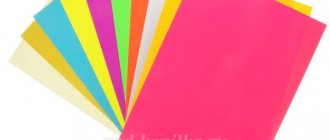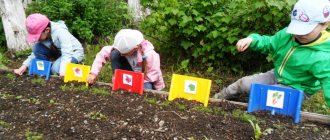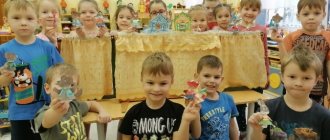MAGAZINE Preschooler.RF
Short-term project “Water Sorceress” for the senior group of preschool educational institutionsProject participants: teacher and senior children.
Project duration: week
Relevance:
Scientific and practical progress is constantly expanding the use of natural resources, and also contributes to the involvement of ever larger territories in human economic activity. The result of this process is the increasing destruction of natural ecological systems. In this regard, issues of caring for nature, preserving its pristine beauty, and improving the protection of biodiversity require urgent solutions
Preschool childhood is the first stage where knowledge about the world around us is intensively accumulated and a multifaceted attitude towards people and nature is formed. The components of the ecological culture of a preschooler’s personality are knowledge about nature and its environmental orientation, the ability to use it in real life, in behavior, in various activities.
Object: Water in our lives.
Hypothesis: We assumed that it is impossible to live without water
Problem: Children lack ideas about the importance of water in human life, about the properties and qualities of water and a careful attitude towards it.
Justification of the problem:
Insufficient knowledge on the physical properties of water, as well as its significance;
Deterioration of the environmental situation
Project goal: To generalize and expand the cognitive interest of preschool children in water as an object of inanimate nature.
Tasks:
- Develop ideas about the properties (taste, color, smell, fluidity) and states of water (solid, liquid, gaseous);
- To develop in children knowledge about the importance of water for all life on earth;
- Develop basic experimentation skills;
- To form a conscious, careful attitude towards water as an important natural resource;
- Development of creative abilities of adults and children in the process of joint activities;
- Improve work on interaction with parents, intensify the position of parents as participants in the pedagogical process of the kindergarten;
- Create conditions for the development of children's cognitive interest, creative imagination and thinking, as well as communication skills.
Expected results:
- Expand and deepen the child’s knowledge and understanding of the world around him, including water.
- Master basic experimentation skills
- Gain experience in humane treatment of plants and living beings.
- Increased knowledge in the field of research skills (establish cause-and-effect relationships).
Project implementation principles:
The principle of differentiation and individualization presupposes the creation of conditions for the full manifestation of the abilities of each child and timely educational work.
The principle of conformity with nature indicates that the educational process corresponds to both internal nature and external conditions.
The principle of dialogic communication as an integral condition for the interaction of subjects, which reflects the close connection between mutual and reciprocal openness, sincerity, mutual understanding of the teacher and the child, and projects an attitude towards reasonable assimilation.
The principle of accessibility provides for the implementation of environmental work taking into account the characteristics of age, preparedness, as well as the individual characteristics and mental development of children.
Systematic principle. Achieving the goal is ensured by solving a set of health, educational and educational tasks with appropriate content, which allows us to obtain a predictable result.
The principle of consistency is to gradually increase requirements in the process of environmental activities.
Project implementation forms:
Ecological activities.
Observations and ecological excursions.
Educational reading.
Laboratory "Experiments" (experiments and experiments).
Outdoor, didactic, simulation games, environmental dramatizations.
Project implementation stages:
Stage I: preparatory
Project resource support:
- Corner of ecology and experimentation in a group
- Methodological tools selection and compilation (card files of didactic games, lesson notes, entertainment scripts, etc.).
- A selection of literature on the topic (encyclopedias, maps, diagrams, fairy tales, poems, puzzles, sayings, etc.).
- A selection of experiences and experiments “Experiments with water”
- Collection of illustrative material
Stage II: main
Direction of work Purpose Benefits and equipment
Block I – Social and communicative development
Conversation “Water, water - water all around” To give children an idea of the importance of water in our lives and the form in which water exists in the environment (states of water - liquid, gaseous, solid).
Develop children's curiosity, thinking and speech; introduce the following words into the children's active dictionary: liquid, colorless, tasteless, transparent.
Foster respect for water. Abstract
Conversation “How does water in the seas and oceans differ from river and lake water?” Give an idea of some types of natural reservoirs, rivers, seas, lakes. Clarify children's knowledge about the location of water in nature and everyday life. The concept that water in reservoirs has different temperatures; depending on the temperature of the water, different plants and animals live in reservoirs. Abstract
Conversation “Cleanliness is beauty” to instill in children the habit of washing themselves, washing their hands with soap before eating, when dirty, after using the toilet; consolidate the ability to use a comb and handkerchief; teach children to turn away when coughing and sneezing and to cover their mouth and nose with a handkerchief. Ensure that children consciously observe the rules of personal hygiene and understand their importance. Cultivate neatness and neatness. Teach the basics of an aesthetic attitude towards your appearance; make it clear to children that a person’s appearance plays an important role in life; continue to consolidate knowledge of cultural and hygienic rules.
Assemble the “Boat”
Development of motor dexterity of the index and thumb of the child’s dominant hand; developing the child’s ability to arrange a mosaic pattern in accordance with the pattern
Mosaic
Finger game “Water - water” , “Washing hands” , “river and fish” , “On the water” Introduce children to new finger gymnastics, teach them to play it, while developing speech and evoking an emotional response. —
Block II – Cognitive development
Riddles “About Water” Effectively exercise the mind, develop thinking abilities. Promote the active development of figurative speech, enrich the vocabulary by deepening and clarifying knowledge about the subject. Help to master the imagery of words, acquire knowledge about word formation, develop a poetic ear and poetic perception Pictures depicting answers
Experiment No. 1: “Properties of water” Introduce children to the properties of water (takes shape, has no smell, taste, color, surface tension, etc.). Several transparent vessels of different shapes, water, three glasses, salt, sugar, a spoon, an odorous solution, dye of different colors
Experiment No. 2 “Water of Life” Introduce children to the life-giving properties of water. Freshly cut branches of quickly blossoming trees, a vessel with water, the label “Water of Living”
Experiment No. 3 “Evaporation” Introduce children to the transformation of water from liquid to gaseous state and back to liquid. Burner, vessel with water, lid for the vessel.
Experiment No. 4 “Aggregative states of water” Prove that the state of water depends on air temperature and is in three states: liquid - water; hard – snow, ice; gaseous - steam. Saucer, snow
Experiment No. 5 “Purification of dirty water” . Reinforce knowledge about the process of water purification in different ways. Plastic tubes, plastic funnel, plastic lid, plastic cup, bag of pebbles, bag of marbles, paper filters, sponge, measuring cup; for a glass, bandage, cotton wool, a glass of dirty water, a plate, oilcloth, a measuring spoon.
Block III – Speech development
Poem by S. Pogorelsky “Spring Stream” , L. Lyushin “Droplet” , E. Moshkovskaya “Drop in the Sea” , G.K. Anderson “Thumbelina” , story by N.A. Ryzhov “How People Offended a River” , “The Story of One pond” , “Once upon a time there was a River” , A fairy tale about the water cycle in nature Nadezhda Boltacheva Formation of interest and need for reading (perception) of books Books
A set of cards with images of a puddle, drops, flowers, steam, mountains, etc.
"Give me a word"
Develop children's speech and motor skills of the speech apparatus Book
IV block – Artistic and aesthetic development
Drawing by dots “Sea inhabitants” Formation of elementary mathematical concepts Sheet of paper, colored pencils
Drawing life-giving moisture Activate thought processes Sheet of paper, colored pencils
Applique “Beautiful fish in an aquarium” Introduce the technique of applicative mosaic. Colored paper, glue
Origami “White Water Lily” Improve your skills in creating three-dimensional paper crafts White paper
Block V – Play activities
Cut-out pictures Develop mental activity, consolidate knowledge about different bodies of water, cultivate a caring attitude towards water Photos of different bodies of water, cut-out pictures of water bodies, flags
Animals of reservoirs To consolidate the idea of the inhabitants of reservoirs, their adaptability to their environment; develop mental activity A set of cards for inhabitants of reservoirs and land, a model of a reservoir
Where are the snowflakes? Reinforce knowledge about the different states of water. Develop memory, cognitive activity Cards depicting different states of water: waterfall, river, puddle, ice, snowfall, cloud, rain, steam, snowflake, etc.
Block VI - Physical development
Outdoor game: “We are droplets” Develop children’s imagination and activity in the game.
Outdoor game: “In the swamp” Teach children to copy the movements of the inhabitants living in the swamp.
Outdoor game “We are big whales” Teach to follow the rules in outdoor games, develop children’s activity in the process of physical activity.
Ball game “Air, earth, water” To consolidate children’s knowledge about natural objects. Develop auditory attention, thinking, intelligence Ball
Creating snow figures Reinforce techniques: rolling, creating a ball, as well as knowledge about the properties of snow; encourage decorative design of the created image; develop the aesthetic and artistic taste of children. Snow, shovels, buckets
Joint activities of parents and children
1. Making a model of individual parts of the aquarium (algae, stones, fish, etc.)
Goal: To develop visual and effective thinking, to stimulate the search for new ways to solve practical problems by making various models, mastering the technique and skills of three-dimensional modeling, acquiring skills in working with paper, cardboard and using various available materials; development of spatial thinking.
2. Finding the necessary materials and collecting the waterfall
Stage III: Final
During the implementation of the “Water Sorceress” , children developed a careful and economical attitude towards water resources. Children mastered simple ways to experiment with water. The children developed age-appropriate research skills (they began to ask natural history questions and establish cause-and-effect relationships). The educational competence of parents in environmental education of preschool children has increased.
Result:
- Enriched and systematized knowledge of children about water, its properties, meaning, etc. A steady interest in studying this topic has been formed
- Increasing the competence of educators on the presented topic
- Developed methodological and didactic support on this issue
- Participation of families of pupils in the educational process.
| Next > |
Environmental project “Water is life” (senior preschool age)
Natalya Kuprina
Environmental project “Water is life” (senior preschool age)
Environmental project on the theme “
Water is life ” (
senior preschool age ) Type of project : short-term, educational and creative
Age group : senior (from September 11 to October 30)
Project participants : children, parents, teachers, swimming instructor
Relevance
Without water, life on Earth . Life arose and exists thanks to the amazing properties of water. More than 70% of the Earth's surface is covered with water. Pay attention to the fact that even such a familiar object as water is fraught with a lot of unknowns. Children need to be taught the skills of environmentally conscious attitudes in everyday life, in particular, to teach children to use water carefully and economically.
Problem
Lack of understanding among children about the importance of water in human life , about the main sources of water pollution, its consequences, measures to prevent water pollution
Objective of the project .
Expand children's knowledge about the properties of water, the importance of water in the life of all life on earth.
Project objectives .
For children:
To generalize and expand children's knowledge about the object of inanimate nature - water. Expand children's knowledge about water, its properties and conditions.
To form ideas about the importance of water in life and all life on Earth. Give an idea of the role of water in the life of humans , plants and animals.
Develop experimental skills; the ability to find ways to solve problem situations.
Enrich your vocabulary. Develop curiosity and cognitive activity
Introduce children to the values of a healthy lifestyle : the habit of washing hands, washing, tempering.
Foster a conscious, careful attitude towards water as an important natural resource. To form ideas among children that water should be conserved.
For parents:
Involving family members of pupils in the educational process; research activities with children.
Create a developing subject-spatial environment in a group on the topic “ Water ”
, supplement the experimentation corner with materials and equipment.
To promote the active involvement of parents in joint activities with the child in family and kindergarten settings.
Joint creative work of parents and children on this topic.
Project products : joint creative work of students and parents on this project (crafts, drawings, posters, presentations, etc.)
Planned results:
The desire to independently use water and learn more about it, using familiar and new methods, methods and techniques, actively using all senses: touch, vision, hearing, taste, smell, sensorimotor actions.
To formulate in children initial ideas about water as a source of life for living organisms
Replenish and expand children's knowledge about the forms and types of water: springs, rivers, seas, lakes, oceans.
Interest in experimentation.
Development of initiative, intelligence, and independence in children.
Readiness for logical cognition.
To increase the educational competence of parents in environmental education of preschool children .
Forms of project : experiments, educational activities, observations, reading fiction on the topic, conversations, work activities.
Project stages :
1. Preparatory
Selecting a topic. Statement of the problem, definition of goals and objectives. Studying methodological literature. Selection of methodological, popular science and fiction literature, illustrated, demonstration, didactic and other material on this topic. project action plan . Discussion with parents about the goals and objectives of the project , clarifying the possibilities and funds necessary to implement the project . Determining the content of activities of all project
2. Main
Contents of the teacher's activities. System of activities for children.
Cognitive activity.
•examination of illustrations from the series: “ Water , where we find it, who needs it”
;
• observing natural phenomena while walking (clouds, rain, snow)
;
•organized educational activities: “Properties of water: cold, warm, hot; liquid, solid, gaseous; without taste, color or smell." "About the benefits of water"
.
•work in nature: caring for indoor plants (timely watering)
.
Research activities.
•Conducting experiments: “ Water liquid , solid, gaseous”
;
“Water has no color, taste or smell”
;
"
Water has no form .
" “Some substances dissolve in water, some do not dissolve
.
“ Water , dissolving substances, acquires their taste, color, and smell.” “
Water can be warm , cold and hot” , etc.
Game activity.
•Didactic games: “Answer quickly”
,
“The fourth wheel”
,
“Yes - no”
,
“Good - bad”
,
the water
hidden ?” ,
“Sky, earth,
water ” ,
“Say a word”
,
“Who can collect it faster?”
.
• Moving, round dancing and finger games.
Speech activity.
•Conversations on the topics: “Autumn”
,
“What kind of
water , its properties” ,
“Where can we find water”
,
“Why do we need it”
,
“About the benefits of water”
,
“What would happen if there was no water”
,
“About caring for water”
, “
Water is needed not only by humans, but also by animals, fish, plants”, “The importance of water in
human life ” ,
“
Water around us ” ,
“Water pollution and how to avoid it”
,
“Who lives in water”
,
“Where can meet water”
,
“Save water together”
,
“What do we know about water”
,
“Natural phenomena”
, etc.
•Reading works of fiction: K. Chukovsky “Fedorino’s grief”
,
"Moidodyr"
;
P. Sinyavsky “Who doesn’t wash himself”
, T. Zhibrova
“Stream”
, G. Vieru
“How a hedgehog washes himself”
, nursery rhyme
“Washbasin”
,
“Rain, rain more”
, riddles about water.
Productive activity.
• Creative works of children and parents on this topic.
Health work.
• Wash hands, face, neck with cool water.
Working with parents:
• involvement of parents in organized educational activities with children;
• participation of parents in the creative process of the project .
3. Final stage
Creation of a card index “Experiments and experiments with water”
.
An exhibition of creative works made by parents and children.
Open display in the pool.
Presentation of the project for children , parents, teachers.
Bibliography:
Veraksa N. E., Galimov O. R. Cognitive and research activities of preschoolers , for working with children 4-7 years old. — MOSAIC-SYNTHESIS, 2014.
Shorygina T. A. Conversations about water in nature. Guidelines. – M.: TC Sfera, 2016. – 96 p.
Shorygina T. A. Conversations about natural phenomena and objects. Guidelines. – M.: TC Sfera, 2022. – 96 p.
Shorygina T. A. Educational fairy tales. Conversations with children about the Earth and its inhabitants. – M.: TC Sfera, 2016. – 80 p.
Internet resources




